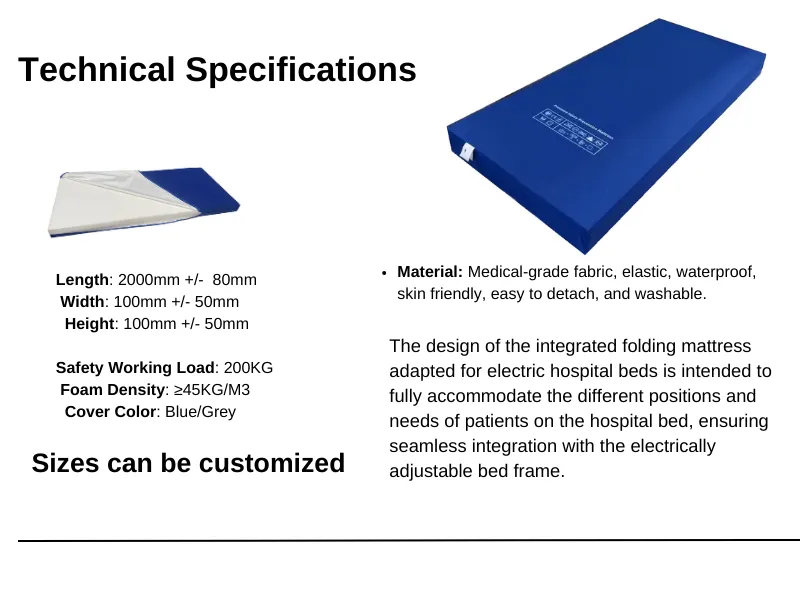Pressure Relieving Mattress for Ultimate Comfort & Pressure Ulcer Prevention Pressure Relieving Foam & Hybrid Options
- Introduction to Pressure Relieving Mattress: Definition, Common Applications, and Medical Significance
- Technological Innovations in Pressure Relieving Foam Mattress
- Comparative Analysis: Foam vs Hybrid Pressure Relieving Mattress
- Manufacturer Comparison: Evaluating Top Brands and Their Offerings
- Custom Solutions for Diverse Patient Needs
- Practical Application Scenarios: Case Studies and Outcomes
- Conclusion: The Future of Pressure Relieving Mattress

(pressure relieving mattress)
Introduction to Pressure Relieving Mattress: A Foundation for Patient Care
Pressure relieving mattress systems play a pivotal role in modern healthcare, particularly in the management and prevention of pressure ulcers. These specialized sleep surfaces distribute body weight more evenly, significantly reducing the risk of tissue breakdown in immobile or at-risk individuals. Approximately 2.5 million patients in the United States develop pressure ulcers annually, according to recent CDC data, highlighting the urgency for advanced support surfaces.
Clinically, a pressure relieving mattress
for pressure ulcers is often prescribed in acute and long-term care environments, benefiting patients undergoing prolonged bed rest, those with compromised mobility, or residents in senior care facilities. Therapeutic outcomes include decreased ulcer incidence rates and enhanced wound healing—key quality indicators for any care provider. Over the past decade, increasing evidence supports that effective mattress technology, when properly integrated with clinical protocols, can reduce pressure ulcer occurrence by up to 60% in high-risk populations.
Technological Innovations in Pressure Relieving Foam Mattress
The evolution of pressure relieving foam mattress designs reflects significant progress in both materials science and ergonomic engineering. Modern medical-grade foams combine viscoelastic (memory) and high-resilience materials, resulting in surfaces that gently conform to patient anatomy while delivering optimal support.
Advanced open-cell structures improve airflow, controlling heat and moisture retention—a critical factor, as excessive moisture triples the risk of skin breakdown. A premium pressure relieving foam mattress may feature multi-layered constructions: for example, a tri-layered model with densities ranging from 30kg/m³ to 60kg/m³ provides both comfort and pressure redistribution.
Innovative cover fabrics, treated with antimicrobial solutions, further reduce infection risks and prolong product life cycles. Controlled clinical interventions with foam mattresses have demonstrated a 50% faster healing trajectory in Stage 1 and 2 ulcers compared to standard hospital mattresses, reinforcing foam’s therapeutic credentials.
Comparative Analysis: Foam vs Hybrid Pressure Relieving Mattress
Selecting the right support surface requires understanding the fundamental differences between pressure relieving foam mattresses and hybrid pressure relieving mattress technologies. Where foam products primarily utilize viscoelastic and high-density polyurethane to disperse weight, hybrid mattresses incorporate additional components (often air cells or springs) to optimize pressure modulation.
| Feature | Foam Mattress | Hybrid Mattress |
|---|---|---|
| Pressure Distribution | Excellent (uniform contouring) | Superior (adaptive zones) |
| Moisture Control | High (open-cell ventilation) | Very High (ventilated & airflow systems) |
| Durability | 5-7 years average | 8-10 years average |
| Weight Capacity | Up to 170kg | Up to 250kg |
| Microclimate Management | Moderate to good | Excellent (integrated sensors & active controls) |
| Healing Support | Effective for Stage 1-2 ulcers | Optimal for Stage 1-4 ulcers |
| Cost (MSRP) | $500 - $1,800 | $1,400 - $4,000+ |
Data from longitudinal clinical trials emphasize that hybrid models reduce ulcer recurrence rates by over 18% compared to high-specification foam alternatives, particularly in bariatric or complex-care settings. The best choice depends on medical requirements, facility resources, and patient profiles.
Manufacturer Comparison: Evaluating Top Brands and Their Offerings
Choosing a pressure relieving mattress involves more than just the technical specifications—it’s also a matter of manufacturer reputation, post-sales support, and compliance with industry standards such as EN 60601, ISO 13485, and FDA guidelines.
| Brand | Flagship Model | Mattress Type | Warranty (Years) | Certifications | Support Services |
|---|---|---|---|---|---|
| Stryker | IsoFlex SE | Hybrid | 7 | FDA, CE | Onsite, Remote Monitoring |
| Invacare | Softform Premier | Foam | 5 | EN, ISO | Dealer Network |
| Hill-Rom | Envision E700 | Hybrid | 10 | FDA, ISO | 24/7 Service, Training |
| Drive DeVilbiss | PresSureGuard 3000 | Foam | 4 | ISO | Standard, Limited |
Reviews consistently place Stryker and Hill-Rom at the top for technological integration and warranty coverage, while Invacare is praised for value-driven foam options. Support services—ranging from on-site maintenance to remote monitoring—enhance product longevity and user satisfaction. For institutional procurement, it’s crucial to assess both performance data and vendor capabilities.
Custom Solutions for Diverse Patient Needs
The effectiveness of a pressure relieving mattress is not solely determined by its baseline configuration; rather, tailored solutions are increasingly common for addressing unique patient risk profiles. Customization pathways include dimension specifications for oversized beds, reinforcement for bariatric use, and adaptive zip-covers for incontinent patients.
- Multi-Firmness Zones: Specific support densities along anatomical zones accommodate variable pressure points, from heels to shoulders.
- Sensor Integration: Embedded pressure sensors provide real-time feedback for dynamic patient repositioning.
- Replaceable Top Layers: Modular designs extend product life, allowing damaged or contaminated sections to be swapped out swiftly.
- Smart Connectivity: Some manufacturers now offer remote adjustment features linked to facility health record systems.
- Specialty Fabrics: High-moisture transfer and vapor-permeable covers address long-term skin health in at-risk populations.
Practical Application Scenarios: Case Studies and Outcomes
Real-world deployment underlines the clinical efficacy and operational value of advanced pressure relieving mattress technologies. In a multi-site long-term care trial (n=1,100 residents), switching from standard foam to hybrid mattresses reduced new Stage 3 and 4 pressure ulcers by 38% over a 12-month span. Another acute care hospital reported a 64% decrease in length of stay associated with pressure ulcer management after introducing high-specification foam products.
Case Study 1: Bariatric ICU Setting
“A regional trauma hospital implemented hybrid pressure relieving mattresses for all bariatric ICU beds. The result: hospital-acquired pressure injury rates dropped from 12% to 4% within six months, with zero reported severe ulcers.”
Case Study 2: Rehabilitation Facility
“Switching to pressure relieving foam mattress models for patients in prolonged rehabilitation correlated with improved patient mobility scores and an average of 2 day-reduction in bed-bound episodes per admission.”
Financially, investment in advanced mattresses pays off: average annual expenditure on wound-related care was reduced by 29% in facilities adopting pressure redistribution technology—a significant boost to both clinical outcomes and bottom-line performance.
Conclusion: The Future of Pressure Relieving Mattress
The advancements in pressure relieving mattress technology signal a profound shift in pressure ulcer prevention and patient comfort. By integrating material innovation, data-driven therapy, and intelligent design, care facilities can now deploy tailored solutions catering to a wider variety of needs. The continuing evolution in both foam and hybrid pressure relieving mattress segments, enhanced by rigorous clinical data and robust manufacturer support, places these products at the forefront of proactive healthcare.
As hospitals, nursing homes, and rehabilitation units accelerate their adoption of evidence-backed support surfaces, the pressure relieving mattress is expected to become a cornerstone in worldwide patient safety initiatives, helping to deliver lower complication rates and improved long-term recovery for vulnerable populations.

(pressure relieving mattress)
FAQS on pressure relieving mattress
Q: What is a pressure relieving mattress?
A: A pressure relieving mattress is designed to redistribute body weight and minimize pressure on sensitive areas. It helps prevent pressure ulcers, especially for patients who are bedridden or have limited mobility. These mattresses use advanced materials like foam or air chambers for better support.Q: Who benefits from using a pressure relieving mattress for pressure ulcers?
A: Patients at risk of pressure ulcers, such as those with limited mobility or who are bedridden, benefit most from these mattresses. They provide consistent support and help reduce the risk of skin breakdown. Hospitals and care homes often use them to enhance patient comfort and health.Q: What makes a pressure relieving foam mattress effective?
A: Pressure relieving foam mattresses use high-density foam that molds to the body’s shape, distributing weight evenly. This feature reduces stress on pressure points and improves circulation. Such mattresses are ideal for preventing pressure sores during long periods of bedrest.Q: How does a hybrid pressure relieving mattress work?
A: A hybrid pressure relieving mattress combines foam with innerspring or air layers for superior support and comfort. This design enhances pressure redistribution and durability. It is suitable for users seeking the benefits of both foam and more traditional mattress structures.Q: Is a pressure relieving mattress easy to maintain?
A: Most pressure relieving mattresses come with removable, washable covers for easy maintenance. Regular cleaning and inspection help extend the mattress's lifespan and ensure hygiene. Always follow the manufacturer's care instructions for the best results.-
Sleep Tracking Mattress Maintenance TipsNewsJul.22,2025
-
Mattress Wave Designs for People with ArthritisNewsJul.22,2025
-
Mattress for Back Pain and Spinal AlignmentNewsJul.22,2025
-
Hypoallergenic Properties of Silicone Gel MattressNewsJul.22,2025
-
How a Gel Memory Foam Mattress Regulates TemperatureNewsJul.22,2025
-
Doctors’ Recommendations on Special Mattress for Back PainNewsJul.22,2025
-
Customizing a Patient Bed Mattress for Specific NeedsNewsJul.22,2025

